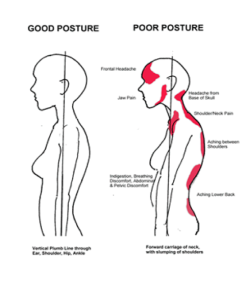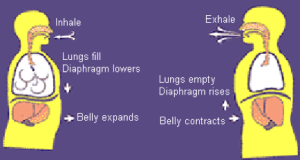This may explain why you constantly have poor posture
One of the most basic body functions that is often overlooked or considered is breathing. Why is breathing so important? How do you assess your breathing? What problems do poor breathing habits result in?
Read on as Scott Bessant our new chiropractor and breathing expert will answer all these questions.
Why is correct breathing so important?
1. Oxygen
It might seem obvious, but the primary benefit of breathing is of course, oxygen. Oxygen has the very inviting side effect of keeping us alive but it also plays a vital role in keeping the chemistry of our body balanced. When we have a full and correct expansion of our lungs, there is a maximal uptake of oxygen into our blood and our optimal chemical balance is maintained, however when we stop utilizing the full potential of our lung fields, there is a reduction in the amount of oxygen uptake that occurs and this results in a state called metabolic acidosis, where the PH balance of our body chemistry drops and in mild cases can present with anxiety, headaches, nausea, muscle weakness and joint pain.
2. Stability and Mobility
The proper use of the diaphragm during breathing creates a cylinder of stability around the lower back and provides the capability for proper core muscle function and like anything, starting with strong foundations is the best way to ensure everything works the way it should. The best way to prevent pain and stiffness throughout the body is by optimizing stability and mobility and that starts with breathing.
3. Posture
When we breath correctly, our shoulder muscles stay relaxed, our core stays strong and our neck stays stable and what can result is an improved posture without you even being aware of the change and this means less stress and less load on our neck, shoulders and back.
What does a poor breathing pattern lead to?
• The most common breathing habit we see is the dominant use of our muscles of the upper chest (pectorals) and muscles of the neck (SCM and Scalenes). Unfortunately these muscles are not designed for 17, 000+ contractions each day and they become tense and create biomechanical changes that cause a painful cascade of events.

This pattern of breathing only allows for shorts, shallow breaths which in turn reduces the amount of oxygen uptake that occurs in our lungs. This can have a variety of effects on our body including anxiety, headaches and muscle pains. A tension within our muscles develops as a response to the lack of oxygen, which can be a reason for the complaints of stiffness and muscle aches.
• The overactivity of the muscles that are forced to work harder during poor respiration leads to a slouched posture where there is an increased load placed upon certain areas causing low back pain, neck pain and headaches amongst other problems.
What does correct breathing look like? Before we tell you, let’s take a test.
1. Sit up right on a chair with your feet flat on the ground.
2. Place one hand on your chest and the other on your belly.
3. Close your eyes and take 3 deeps breathes in.
4. Take note of where most of the expansion is coming from. If you can’t tell where it is happening, open your eyes and then do this in front of a mirror or get someone to film you from the side.
If you found most of the expansion is from your hand on your chest or upper body (i.e. chest, neck and shoulders) then unfortunately you have poor breathing pattern that may cause you some underlying problems as mentioned above.
When breathing correctly,
We should only use 1 muscle when breathing, the Diaphragm.

•When taking a breath in, the following occurs;
1. the diaphragm contracts and lowers
2. the lungs expand downwards and pushes the abdominal contents down and the ‘belly’ out.
3. Then a smaller expansion of the chest follows, with no elevation of the shoulders.
• When breathing out the reverse occurs, however exhalation is initiated by the relaxation of the Diaphragm.
Why do I have a poor breathing pattern?
This is not a simple question to answer as you may have had a poor breathing pattern for a long time but not have known about it until now!
For some people it may have started simply as;
• A result of an injury or pain
• Being in a stressful environment i.e. work
• Being taught to breathe incorrectly from the chest for cosmetic reasons i.e. ballet dancers, army or police recruits.
• Respiratory conditions i.e. asthma, blocked sinuses, sleep apnoea etc.
What can I do if I have a poor breathing pattern?
It’s good to know that if you have a poor breathing pattern, then there is something you can do about it.
Firstly, through a thorough assessment, we can identify your breathing pattern and even show how it may be linked to your symptoms. Often manual treatment may be required to get the process started. Then breathing exercises will re-train you on how to breathe properly again.
If you think you have a poor breathing pattern, please get in touch with us so we can help you correct this problem.
Scott is at the practice on Monday, Wednesday and Fridays.
If you would like to make an appointment, click here and make an ‘Initial Consultation’ with Scott.
Scott has a Masters in Chiropractic and his passion for function and performance developed during his time at University where he began developing his interests through attending a variety of seminars including the International Federation of Sports Chiropractic Sports symposium and completing a Functional Sports Chiropractic course that allowed for the development of a deep understanding of movement dysfunction, mobility, stability and rehabilitation. He has also completed his sports trainer level 1 course and musculoskeletal dry needling.
His treatment approach has a focus on correcting movement dysfunctions with thorough assessment and a wide range of modalities including muscle release techniques, dry needling, manual mobilisations and stability exercises. Scott has, through external learning, gained an understanding of functional stability through the application of rehabilitation and breathing corrections that aid in the optimisation of correct body function.
Health and fitness has always been a high priority for Scott, who has actively involved himself in sports including Rugby league, Rugby Union and Surfing and he has consistently maintained a functional approach to resistance training that has furthered his ability to apply an understanding to improving performance.


